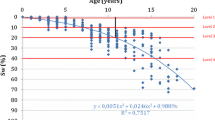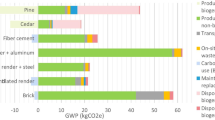Abstract
Purpose
Service life of building products has an important influence on life cycle assessment (LCA) results of buildings. The goal of this study was to propose a systematic approach to estimate service life of building products by including both technical and social factors.
Methods
A hybrid service life prediction method, combining the statistical approach described in American Society for Testing and Materials standard G166 with the Factor Method adopted by International Organization for Standardization standard 15686, was proposed. In their current forms, the two methods are not suitable to provide reliable lifetime estimates for the wide variety of products that are used in buildings. Statistical analysis was preferred over a deterministic approach. Regression analysis was used to define Weibull distribution parameters for each product. These distributions were then used to calculate the mean estimated service life of products with an 80% confidence interval. Using actual lifetime observed from practice instead of design lifetime for reference service life was preferred. This enables the use of a smaller range of coefficients for each factor affecting service life, which decreases subjectivity and increases reliability of results.
Results and discussion
Example median service life estimates were demonstrated for common residential interior finishes that are replaced more frequently, and therefore require more maintenance planning and potentially have significant environmental impacts. Probability of renovation distributions was also presented for interior finishes. The proposed method inherently includes social factors in the dataset used to define lifetime distributions, which could be as important as durability for some building product categories. Another advantage is that choosing reference service life based on real-life conditions decreases the range of coefficients necessary for modifying factors in comparison to when design lifetime is used, thus decreasing the subjectivity of results due to variations in assigned values by different users.
Conclusions
The Factor Method is the most promising method available to estimate service life of products. Unless additional data points were gathered for investigated products, the presented lifetime distribution results can be directly applied to LCA studies. The proposed hybrid method can also be applied to other products that are studied within the Factor Method. Products whose lifetimes are influenced by social factors are prime candidates to apply this method.

Similar content being viewed by others
References
Aarseth LI, Hovde PJ (1999) Stochastic approach of the factor method for estimating service life. In: Lacasse MA, Vanier DJ (eds) 8th International Conference on Durability of Building Materials and Components (DBMC). NRC Research Press, Ottawa, pp 1247–1256
Abu-Tair AI, McParland C, Lyness JF, Nadjai A (2002) Predictive models of deterioration rates of concrete bridges using the factor method based on historic inspection data. In: 9th International Conference on Durability of Building Materials and Components (DBMC), Brisbane, Australia
Adalberth K (1997) Energy use during the life cycle of buildings: a method. Build Environ 32(4):317–320
Anderson T, Brandt E (1999) The use of performance and durability data in assessment of life time serviceability. In: Lacasse MA, Vanier DJ (eds) 8th International Conference on Durability of Building Materials and Components (DBMC). NRC Research Press, Ottawa, pp 1813–1820
Anderson J, Shiers DE, Sinclair M (2002) The green guide to specification: an environmental profiling system for building materials and components, 3rd edn. Blackwell Science, Malden
ASTM (2003) G 172—standard guide for statistical analysis of accelerated service life data. ASTM International, West Conshohocken
ASTM (2005) G 166—Standard Guide for Statistical Analysis of Service Life Data. ASTM International, West Conshohocken
Chown GA, Brown WC, Kyle BR, Lacasse MA, Vanier DJ (1996) Applying service life and asset management techniques to roofing systems. In: Sustainable Low-Slope Roofing Workshop, Oak Ridge, Tennessee, Oct 9–10 1996. Oak Ridge National Laboratory, U.S. Department of Energy, pp. 103–115
Cooper T (2004) Inadequate life? Evidence of consumer attitudes to product obsolescence. J Consum Policy 27(4):421–449
Daniotti B, Cecconi FR (2010) Test methods for service life prediction—state of the art report on accelerated laboratory test procedures and correlation between laboratory tests and service life data. W080—prediction of service life of building materials and components. International Council for Research and Innovation in Building and Construction, Rotterdam
Davies H, Wyatt D (2004) Appropriate use of the ISO 15686-1 factor method for durability and service life prediction. Build Res Inf 32(6):552–553
Fay R, Treloar G, Iyer-Raniga U (2000) Life-cycle energy analysis of buildings: a case study. Build Res Inf 28(1):31–41
Fernandez JE (2003) Design for change: Part 1: diversified lifetimes. Archit Res Q 7(2):169–182
Frohnsdorff GJ, Martin JW (1996) Towards prediction of building service life: the standards imperative. In: Sjostrom C (ed) 7th International Conference on Durability of Building Materials and Components. E & FN Spon, New York, pp 1417–1428
Gaspar PL, de Brito J (2008) Service life estimation of cement-rendered facades. Build Res Inf 36(1):44–55
Gorree M, Guinee JB, Huppes G, van Oers L (2002) Environmental life cycle assessment of linoleum. Int J Life Cycle Assess 7(3):158–166
Gunther A, Langowski H-C (1997) Life cycle assessment study on resilient floor coverings. Int J Life Cycle Assess 2(2):73–80
Hed G (1999) Service life planning of building components. In: Lacasse MA, Vanier DJ (eds) 8th International Conference on Durability of Building Materials and Components (DBMC). NRC Research Press, Ottawa, pp 1543–1551
Hooper R, Bourke K, Ferguson WA, Clift M (2002) An integrated approach to durability assessment throughout construction procurement. In: 9th International Conference on Durability of Building Materials and Components, Brisbane, Australia 2002
Hovde PJ, Moser K (2004) Performance based methods for service life prediction—state of the art reports part A & part B. CIB W080/RILEM 175-SLM service life methodologies prediction of service life for buildings and components. International Council for Research and Innovation in Building and Construction (CIB), Rotterdam
ISO (2000) ISO 15686-1:2000—buildings and constructed assets—service life planning—part 1: general principles. ISO, Geneva
Jernberg P, Sjostrom C, Lacasse MA, Brandt E, Siemes T, Haagenrud SE, Kucera V, Odeen K, Lewry A, Schwarz H-J, Yates T, Grondin GY (2004) Guide and bibliography to service life and durability research for building materials and components. International Council for Research and Innovation in Building and Construction (CIB), Rotterdam
Jonsson A (1999) Including the use phase in LCA of floor coverings. Int J Life Cycle Assess 4(6):321–328
Jonsson A, Tillman A-M, Svensson T (1997) Life cycle assessment of flooring materials: case study. Build Environ 32(3):245–255
Kelly DJ (2007) BRE, design life of buildings—a scoping study. Scottish Building Standards Agency, Glasgow
Keoleian GA, Blanchard S, Reppe P (2001) Life-cycle energy, costs, and strategies for improving a single-family house. J Ind Ecol 4(2):135–156
Lacasse MA (2008) Advances in service life prediction—an overview of durability and methods of service life prediction for non-structural building components. In: Annual Australasian Corrosion Association Conference, Wellington, New Zealand 2008, pp. 1–13
Lacasse MA, Sjostrom C (2004) Recent advances in methods for service life prediction of building materials and components—an overview. In: CIB World Building Congress, Toronto, Canada
Lacasse MA, Sjostrom C (2005) Advances in methods for service life prediction of building materials and components—final report—activities of the CIB W80. In: 10th International Conference on Durability of Building Materials and Components (DBMC), Lyon, France
Lippiatt BC (2008) Building for Environmental and Economic Sustainability (BEES). 4.0 edn.. The National Institute of Standards and Technology (NIST), Gaithersburg
Lounis Z, Lacasse MA, Siemes AJM, Moser K (1998) Further steps towards a quantitative approach to durability design In: Construction and the Environment-CIB World Building Congress, Gavle, Sweden
Marteinsson B (2003) Durability and the factor method of ISO 15686-1. Build Res Inf 31(6):416–426
Marteinsson B (2005) Service life estimation in the design of buildings—a development of the factor method. KTH Research School, Gavle
Masters LW, Brandt E (1987) Prediction of service life of building materials and components. Mater Struct 20(1):55–77
Mithraratne N, Vale B (2004) Life cycle analysis model for New Zealand houses. Build Environ 39(4):483–492
Moser K (1999) Towards the practical evaluation of service life—illustrative application of the probabilistic approach. In: Lacasse MA, Vanier DJ (eds) 8th International Conference on Durability of Building Materials and Components (DBMC). NRC Research Press, Ottawa, pp 1319–1329
Moser K, Edvardsen C (2002) Engineering design methods for service life prediction. In: 9th International Conference on Durability of Building Materials and Components, Brisbane, Australia
Nebel B, Zimmer B, Wegener G (2006) Life cycle assessment of wood floor coverings. Int J Life Cycle Assess 11(3):172–182
Nicastro DH, Surovek AE (2005) Defects, deterioration, and durability. In: Ratay RT (ed) Structural condition assessment. Wiley, Hoboken, pp 3–23
NIST (2010) e-Handbook of statistical methods. NIST, Gaithersburg
NYC Housing Maintenance Code (2006)—subchapter 2: maintenance, services, and utilities—Article 3: painting. New York City
Optis M, Wild P (2010) Inadequate documentation in published life cycle energy reports on buildings. Int J Life Cycle Assess 15(7):644–651
Paulsen JH (2003) The maintenance of linoleum and PVC floor coverings in Sweden. Int J Life Cycle Assess 8(6):357–364
Petersen AK, Solberg B (2004) Greenhouse gas emissions and costs over the life cycle of wood and alternative flooring materials. Clim Chang 64(1–2):143–167
Pommersheim J, Clifton J (1985) Prediction of concrete service-life. Mater Struct 18(1):21–30
Potting J, Blok K (1995) Life cycle assessment of four types of floor covering. J Clean Prod 3(4):201–213
Pullen S (2000) Energy assessment of institutional buildings. In: 34th Annual Conference of the Australia & New Zealand Architectural Science Association, Adelaide, Australia 2000
Rudbeck C (1999) Methods for designing building envelope components prepared for repair and maintenance. Technical University of Denmark, Lyngby
Scharai-Rad M, Welling J (2002) Environmental and energy balances of wood products and substitutes. Food and Agriculture Organization of the United Nations, Rome
Scheuer C, Keoleian GA, Reppe P (2003) Life cycle energy and environmental performance of a new university building: modeling challenges and design implications. Energy Build 35(10):1049–1064
Seiders D, Ahluwalia G, Melman S, Quint R, Chaluvadi A, Liang M, Silverberg A, Bechler C (2007) Study of life expectancy of home components. National Association of Home Builders, Washington, DC
Shohet IM, Paciuk M (2004) Service life prediction of exterior cladding components under standard conditions. Constr Manag Econ 22(10):1081–1090
Shohet IM, Paciuk M (2006) Service life prediction of exterior cladding components under failure conditions. Constr Manag Econ 24(2):131–148
Sjostrom C, Jernberg P, Frohnsdorff G (2001) international standards for design life of constructed assets. In: CIB World Building Congress, New Zealand
Sjostrom C, Jernberg P, Caluwaerts P, Kelly S, Haagenrud S, Chevalier JL (2002) Implementation of the European Construction Products Directive via the ISO 15686 Standards. In: 9th International Conference on Durability of Building Materials and Components, Brisbane, Australia
Strand SM, Hovde PJ (1999) Use of service life data in LCA of building materials. In: Lacasse MA, Vanier DJ (eds) Durability of building materials and components 8. Institute for Research in Construction, NRC Research Press, Ottawa, pp 1948–1958
Thormark C (2002) A low energy building in a life cycle—its embodied energy, energy need for operation and recycling potential. Build Environ 37(4):429–435
Winther BN, Hestnes AG (1999) Solar versus green: the analysis of a Norwegian row house. Sol Energy 66(6):387–393
Author information
Authors and Affiliations
Corresponding author
Additional information
Responsible editor: Martin Baitz
Rights and permissions
About this article
Cite this article
Aktas, C.B., Bilec, M.M. Service life prediction of residential interior finishes for life cycle assessment. Int J Life Cycle Assess 17, 362–371 (2012). https://doi.org/10.1007/s11367-011-0367-6
Received:
Accepted:
Published:
Issue Date:
DOI: https://doi.org/10.1007/s11367-011-0367-6




